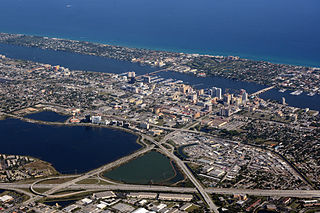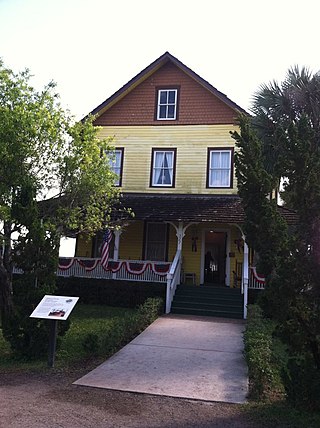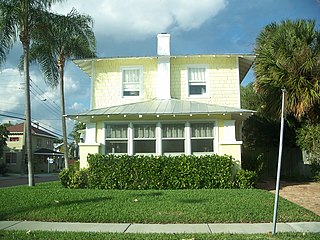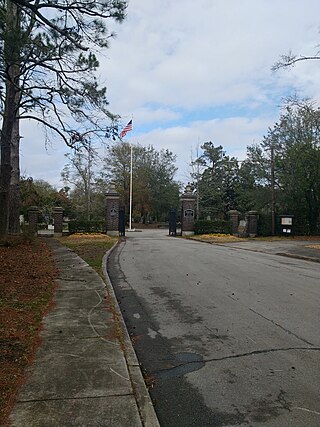
Palm Beach County is a county in the southeastern part of Florida, located in the Miami metropolitan area. It is Florida's third-most populous county after Miami-Dade County and Broward County and the 26th-most populous in the United States, with 1,492,191 residents as of the 2020 census. Its county seat and largest city is West Palm Beach, which had a population of 117,415 as of 2020. Named after one of its oldest settlements, Palm Beach, the county was established in 1909, after being split from Dade County. The county's modern-day boundaries were established in 1963.

Palm Beach is an incorporated town in Palm Beach County, Florida, United States. Located on a barrier island in east-central Palm Beach County, the town is separated from West Palm Beach and Lake Worth Beach by the Intracoastal Waterway to its west and a small section of the Intracoastal Waterway and South Palm Beach to its south. It is part of the South Florida metropolitan area. As of the 2020 census, Palm Beach had a year-round population of 9,245.

Hollywood Forever Cemetery is a full-service cemetery, funeral home, crematory, and cultural events center which regularly hosts community events such as live music and summer movie screenings. It is one of the oldest cemeteries in Los Angeles, California and is located at 6000 Santa Monica Boulevard in the Los Angeles neighborhood of Hollywood. It was founded in 1899 as Hollywood Cemetery, and, from 1939, was known as Hollywood Memorial Park until 1998 when it was given its current name. The studios of Paramount Pictures are located at the south end of the same block, on 40 acres (16 ha) that were once part of the cemetery which held no interments.

Dixie Highway was a United States auto trail first planned in 1914 to connect the Midwest with the South. It was part of a system and was expanded from an earlier Miami to Montreal highway. The final system is better understood as a network of connected paved roads, rather than one single highway. It was constructed and expanded from 1915 to 1929.

Oakland Cemetery is one of the largest cemetery green spaces in Atlanta, Georgia, U.S. Founded as Atlanta Cemetery in 1850 on six acres (2.4 hectares) of land southeast of the city, it was renamed in 1872 to reflect the large number of oak and magnolia trees growing in the area. By that time, the city had grown and the cemetery had enlarged correspondingly to the current 48 acres (190,000 m2). Since then, Atlanta has continued to expand so that the cemetery is now located in the center of the city. Oakland is an excellent example of a Victorian-style cemetery, and reflects the "garden cemetery" movement started and exemplified by Mount Auburn Cemetery in Massachusetts.
The barefoot mailman is an iconic Florida symbol. It refers to the carriers on the first U.S. Mail route (1885–1892) between Palm Beach and the settlements around Lake Worth on the north, and Miami, Coconut Grove, and Lemon City to the south. The mailmen had to walk and travel by boat because there was no road connecting the 68-mile route from Palm Beach to Miami. Approximately 28 miles of the one way trip was by rowing different boats, and the rest by walking along the firmer sand along the beach. The route was a Star Route, with the carriers contracting with the Post Office. The route was originally called the "barefoot route" and the carriers were called "beach walkists" or "beach walkers". It was not until around 1940 that the term "barefoot mailman" came into use.

The Riddle House is an old Edwardian house located in Palm Beach County, Florida. The house was built in West Palm Beach, Florida in 1905 by some of Henry Flagler's hotel construction workers. Originally known as "Gatekeeper's Cottage", the house was home to the groundskeeper of Woodlawn Cemetery. By 1920, the house became privately owned by Karl Riddle, a city manager and superintendent of West Palm Beach. He is the namesake of the house. The house was eventually dismantled and moved to Yesteryear Village in 1995, a historical park within the South Florida Fairgrounds. The building was featured in an episode of Ghost Adventures in 2008.

The El Cid Historic District is a U.S. historic district located in West Palm Beach, Florida. The district is bounded by Flamingo Drive, South Flagler Drive, Dyer Road and South Dixie Highway. It contains 281 historic buildings.

The Mango Promenade Historic District is a U.S. historic district located in West Palm Beach, Florida. The district is bounded by South Dixie Highway, Austin Lane, Coconut Lane, and Cranesnest Way. It contains 125 historic buildings.

The Hurricane of 1928 African-American Mass Burial Site is a pauper's cemetery and mass grave in West Palm Beach, Florida. It is listed on the U.S. National Register of Historic Places. The cemetery is situated near the junction of 25th Street and Tamarind Avenue between I-95 and U.S. Route 1. The site is the location in which 674 bodies of African Americans or those of an unknown race were buried following the 1928 Okeechobee hurricane, while most of the white victims of the storm received a proper burial at Woodlawn Cemetery due to segregation laws.

The Brelsford House was a historic home in Palm Beach, Florida, United States, located at 1 Lake Trail. Built between 1888 and 1903, it was added to the National Register of Historic Places on May 3, 1974. The Neoclassical house was destroyed in August of the following year, but it remains on the Register.
Confederate monuments and memorials in the United States include public displays and symbols of the Confederate States of America (CSA), Confederate leaders, or Confederate soldiers of the American Civil War. Many monuments and memorials have been or will be removed under great controversy. Part of the commemoration of the American Civil War, these symbols include monuments and statues, flags, holidays and other observances, and the names of schools, roads, parks, bridges, buildings, counties, cities, lakes, dams, military bases, and other public structures. In a December 2018 special report, Smithsonian Magazine stated, "over the past ten years, taxpayers have directed at least $40 million to Confederate monuments—statues, homes, parks, museums, libraries, and cemeteries—and to Confederate heritage organizations."
The history of West Palm Beach, Florida, began more than 5,000 years ago with the arrival of the first aboriginal natives. Native American tribes such as the Jaegas inhabited the area. Though control of Florida changed among Spain, England, the United States, and the Confederate States of America, the area remained largely undeveloped until the 20th century. By the 1870s and 1880s, non-Native American settlers had inhabited areas in the vicinity of West Palm Beach and referred to the settlement as "Lake Worth Country". However, the population remained very small until the arrival of Henry Flagler in the 1890s. Flagler constructed hotels and resorts in Palm Beach to create a travel destination for affluent tourists, who could travel there via his railroad beginning in 1894.

Charles William Pierce was one of South Florida's most important pioneer citizens. Arriving in 1872, Pierce was a community leader in banking, seamanship, the postal service, and author of the sentinel book on early South Florida life.

More than 160 monuments and memorials to the Confederate States of America and associated figures have been removed from public spaces in the United States, all but five since 2015. Some have been removed by state and local governments; others have been torn down by protestors.

Oakdale Cemetery is a cemetery in Wilmington, North Carolina that dates from the 19th century.














